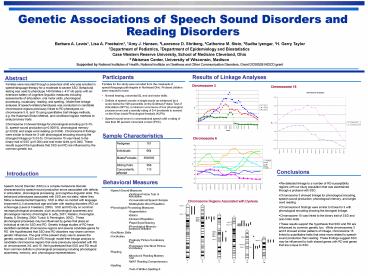Abstract - PowerPoint PPT Presentation
1 / 1
Title:
Abstract
Description:
Model-free linkage analyses of speech-related phenotypes was conducted on ... methods, e.g. the Haseman-Elston Method, and conditional logistic methods to ... – PowerPoint PPT presentation
Number of Views:272
Avg rating:3.0/5.0
Title: Abstract
1
Genetic Associations of Speech Sound Disorders
and Reading Disorders
Barbara A. Lewis1, Lisa A. Freebairn1, 1Amy J.
Hansen, 3Lawrence D. Shriberg, 2Catherine M.
Stein, 2Sudha Iyengar, 1H. Gerry
Taylor 1Department of Pediatrics, 2Department of
Epidemiology and Biostatistics Case Western
Reserve University, School of Medicine Cleveland,
Ohio 3 Waisman Center, University of Wisconsin,
Madison Supported by National Institutes of
Health, National Institute on Deafness and Other
Communication Disorders, Grant DC00528 NIDCD
grant
Participants
Results of Linkage Analyses
Abstract
Families were recruited through a preschool child
who was enrolled in speech/language therapy for a
moderate to severe SSD. Behavioral testing was
used to phenotype 149 families (417 sib pairs)
with an extensive battery of cognitive-linguistic
measures including assessments of articulation,
oral motor skills, phonological processing,
vocabulary, reading, and spelling. Model-free
linkage analyses of speech-related phenotypes was
conducted on candidate chromosome regions
previously linked to RD phenotypes on chromosome
3, 6, and 15 using quantitative trait linkage
methods, e.g. the Haseman-Elston Method, and
conditional logistic methods to analyze binary
traits. Chromosome 3 showed linkage for
phonological encoding (p2x10-5), speech-sound
production (p0.00015), phonological memory
(p0.023) and single word reading (p0.004).
Chromosome 6 findings were similar to those for 3
with phonological encoding showing the strongest
linkage (p7x10-5). Chromosome 15 was linked to
the binary trait of SSD (p0.004) and oral motor
skills (p0.048). These results support the
hypothesis that SSD and RD are influenced by the
common genetic loci.
- Families for the study were recruited from the
caseloads of - speech/language pathologists in Northeast Ohio.
Proband children - were required to have
- Normal hearing, nonverbal IQ, and oral motor
skills. - Deficits of speech sounds in single words as
evidenced by a score below the 10th percentile on
the Goldman-Fristoe Test of Articulation (GFTA),
a minimum occurrence of four phonological process
errors and a severity rating of 3-4 (moderate to
severe) on the Khan-Lewis Phonological Analysis
(KLPA) - Speech-sound errors in conversational speech with
a rating of less than 90 percent consonant
correct (PCC).
Chromosome 3
Chromosome 15
Sample Characteristics
Chromosome 6
Conclusions
Introduction
Behavioral Measures
- We detected linkage to a number of
RD-susceptibility regions with our study
population that was ascertained through a proband
with SSD. - Chromosome 3 showed linkage for phonological
encoding, speech-sound production, phonological
memory, and single word reading. - Chromosome 6 findings were similar to those for 3
with phonological encoding showing the strongest
linkage. - Chromosome 15 was linked to the binary trait of
SSD and oral motor skills. - These results support the hypothesis that SSD and
RD are influenced by common genetic loci. While
chromosomes 3 and 6 showed similar patterns of
linkage, chromosome 15 linked to quantitative
traits that were more related to speech- sound
production than reading. These findings suggest
SSD may be influenced by both shared genes with
RD and genes that are unique to SSD.
Speech Sound Disorder (SSD) is a complex
behavioral disorder characterized by speech-sound
production errors associated with deficits in
articulation, phonological processing, and
cognitive-linguistic skills. The behavioral
phenotypes associated with SSD are not static
rather they follow a developmental trajectory.
SSD is often co-morbid with language impairment
(LI) at preschool age and later with reading
disorders (RD) at school-age (Lewis Freebairn,
2000). SSD and RD rely on common
neuropsychological processes, such as
phonological awareness and phonological memory
(Pennington Lefly, 2001 Raitano, Pennington,
Boada, Shriberg, 2004 Tunick Pennington,
2002). These phonological processes may be
influenced by genes that place an individual at
risk for SSD and RD. Genetic linkage studies of
RD have identified candidate chromosome regions
and several candidate genes for RD. We
hypothesized that SSD and RD disorders may share
common genetic influences. The goal of the
present study was to assess the genetic overlap
of SSD and RD through model-free linkage analysis
to candidate chromosome regions that were
previously associated with RD on chromosomes 3,6,
and 15. We hypothesized that SSD and RD result
from common deficits in phonological processing
including phonological awareness, memory, and
phonological representations.
- Speech Sound Measures
- Goldman-Fristoe Test of Articulation
- Conversational Speech Sample
- Multisyllabic Word Repetition
- Phonological Processing Measures
- Segmentation
- Elision
- Nonword Repetition
- Rapid Serial Naming
- Phonological Memory- Sentence Imitation
- Oral Motor Skills
- Vocabulary
- Peabody Picture Vocabulary Test
- Expressive One Word Picture Vocabulary
- Reading
- Woodcock Reading Mastery Test
- WIAT Reading Comprehension
- Spelling
- Test of Written Spelling-3
Chromosome Regions Associated with Dyslexia

